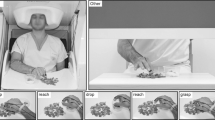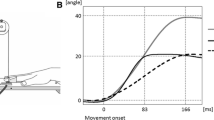Abstract
We studied the relationship between the velocity of movement illusion and the activity level of primary motor area (M1) and of the left angular gyrus (AG) in humans. To induce illusory movement perception, we applied co-vibration at different frequencies on tendons of antagonistic muscle groups. Since it is well established that the velocity of illusory movement is related to the difference in vibration frequency applied to two antagonistic muscles, we compared magnetoencephalography (MEG) signals recorded in two conditions of co-vibration: in the “fast illusion” condition a frequency difference of 80 Hz was applied on the tendons of the right wrist extensor and flexor muscle groups, whereas in the “slow illusion” condition a frequency difference of 40 Hz was applied on the same muscle groups. The dipole strength, reflecting the activity level of structures, was measured over M1 and the left AG in two different time-periods: 0–400 and 400–800 ms in each condition. Our results showed that the activity level of the AG was similar in both conditions whatever the time-period, whereas the activity level of M1 was higher in the “fast illusion” condition compared to the “slow illusion” condition from 400 ms after the vibration onset only. The data suggest that the two structures differently contributed to the perception of illusory movements. Our hypothesis is that M1 would be involved in the coding of cinematic parameters of the illusory movement but not the AG.

Similar content being viewed by others
References
Ashe J, Georgopoulos AP (1994) Movement parameters and neural activity in motor cortex and area 5. Cereb Cortex 4:590–600
Burke D, Hagbarth KE, Lofstedt L, Wallin BG (1976) The response of human muscle spindle endings to vibration during isometric contraction. J Physiol 261:695–711
Blinkenberg M, Bonde C, Holm S, Svarer C, Andersen J, Paulson OB, Law I (1996) Rate dependence of regional cerebral activation during performance of a repetitive motor task: a PET study. J Cereb Blood Flow Metab 16:794–803
Calvin-Figuière S, Romaiguère P, Gilhodes JC, Roll JP (1999) Antagonist motor responses correlate with kinesthetic illusions induced by tendon vibration. Exp Brain Res 124:342–350
Casini L, Romaiguère P, Ducorps A, Schwartz D, Anton JL, Roll JP (2006) Cortical correlates of illusory hand movement perception in humans: a MEG study. Brain Res 1121:200–206
De Jong BM, Willemsen ATM, Paans AMJ (1999) Brain activation related to the change between bimanual motor programs. NeuroImage 9:290–297
Duvernoy HM (1991) The human brain surface, blood supply, and the three dimensional sectional anatomy. Springer, Wien NewYork
Gilhodes JC, Roll JP, Tardy-Gervet MF (1986) Perceptual and motor effects of ago-antagonist muscle vibration in man. Exp Brain Res 61:395–402
Goodwin GM, McCloskey DI, Matthews PBC (1972) The contribution of muscle afferents to kinaesthesia shown by vibration induced illusions of movement and by the effects of paralysing joint afferents. Brain 95:705–748
Hamalainen MS (1992) Magnetoencephalography: a tool for functional brain mapping. Brain Topogr 5:95–102
Hari R (1991) On brain’s magnetic responses to sensory stimuli. J Clin Neurophysiol 8:157–169
Humphrey DR, Schmidt EM, Thompson WD (1970) Predicting measures of motor performance from multiple cortical spike trains. Science 178:758–762
Iacoboni M, Woods R, Brass M, Bekkering H, Mazziota J, Rizzolatti G (1999) Cortical mechanisms of human imitation. Science 286:2526–2528
Jäncke L, Peters M, Schlaug G, Posse S, Steinmetz H, Müller-Gärtner HW (1998) Differential magnetic resonance signal change in human sensorimotor cortex to finger movements of different rate of the dominant and subdominant hand. Cog Br Res 6:279–284
Naito E, Ehrsson HH, Geyer S, Zilles K, Roland PE (1999) Illusory hand movements activate cortical motor areas: a positron emission tomography study. J Neurosci 19:6134–6144
Nieuwenhuys R, Voogd J, Van Huijzen C (1988) The human central nervous system: a synopsis and atlas. Springer, Berlin
Radovanovic S, Korotkov A, Ljubisavljevic M, Lyskov E, Thunberg J, Kataeva G, Danko S, Roudas M, Pakhomov S, Medvedev S, Johansson H (2002) Comparison of brain activity during different types of proprioceptive inputs: a positron emission tomography study. Exp Brain Res 144:276–285
Rao SM, Bandetinni PA, Binder JR, Bobholz JA, Hammeke TA, Stein EA, Hyde JS (1996) Relationship between finger movement rate and functional magnetic resonance signal change in human primary motor cortex. J Cereb Blood Flow Metab 16:1250–1254
Roll JP, Vedel JP (1982) Kinesthetic role of muscle afferents in man studied by tendon vibration and microneurography. Exp Brain Res 47:177–190
Roll JP, Vedel JP, Ribot E (1989) Alteration of proprioceptive messages induced by tendon vibration in man: a microneurographic study. Exp Brain Res 76:213–222
Romaiguère P, Anton JL, Roth M, Casini L, Roll JP (2003) Motor and parietal cortical areas both underlie kinaesthesia. Cog Brain Res 16:74–82
Rushworth MFS, Johansen-Berg H, Göbel SM, Devlin JT (2003) The left parietal and premotor cortices: motor attention and selection. NeuroImage 20:89–100
Schlaug G, Sanes JN, Thangaraj V, Edelman RR, Warach S (1996) Cerebral activation covaries with movement rate. Neuroreport 7:879–883
VanMeter JW, Maisog JM, Zeffiro TA, Hallett M, Herscovitch P, Rapoport SI (1995) Parametric analysis of functional neuroimages: application to variable-rate motor task. Neuroimage 2:273–283
Author information
Authors and Affiliations
Corresponding author
Rights and permissions
About this article
Cite this article
Casini, L., Roll, JP. & Romaiguère, P. Relationship between the velocity of illusory hand movement and strength of MEG signals in human primary motor cortex and left angular gyrus. Exp Brain Res 186, 349–353 (2008). https://doi.org/10.1007/s00221-008-1325-9
Received:
Accepted:
Published:
Issue Date:
DOI: https://doi.org/10.1007/s00221-008-1325-9




